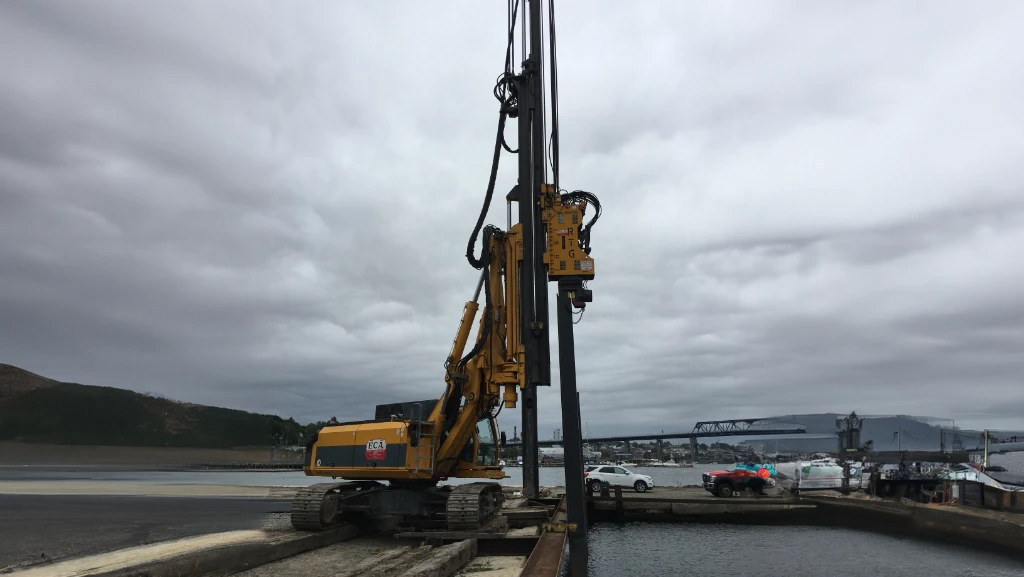Pile driving is a crucial part of many construction projects, providing a solid foundation for buildings, bridges, and other structures. Traditionally, pile driving has been done using hydraulic hammers, but the advent of vibratory hammers has revolutionized this process. Vibratory hammers generate vibration to drive the pile into the ground and have become increasingly popular due to their speed, efficiency, and lower impact on the environment.
One type of vibratory hammer that has gained popularity is the Variable Moment Vibratory Hammer (VMVH). The VMVH utilizes a Variable Moment Driver (VMD) that enables the operator to control the amplitude of the vibration in real-time. This allows the operator to adjust the vibration according to the specific soil conditions, which improves the drivability of the pile while minimizing the impact on nearby structures and the environment.
So how does the Variable Moment Vibratory Hammer work, and what are the differences between it and regular vibratory hammers? Let’s take a closer look.
Mechanism of Operation
A conventional vibratory hammer generates a fixed level of vibration. On the other hand, the VMVH generates variable amplitude vibration. This is achieved through the use of two sets of eccentrics. One set opposes the other during startup and shutdown, causing the hammer to have no moment or energy. During operation, the two sets of eccentrics are phased in and out of time with each other to create amplitude or moment (energy). This feature gives the operator infinite amplitude control, minimizing the radial vibration in the surrounding soil and maximizing the drivability of the pile.
Differences from Regular Vibratory Hammers
The primary difference between the VMVH and regular vibratory hammers is the ability to adjust the amplitude of the vibration in real-time. Regular vibratory hammers have a fixed level of amplitude that cannot be adjusted during operation. The VMD allows for a more customized approach to pile driving operations, increasing the accuracy and efficiency of the process.
Another significant difference is the impact on the surrounding environment. Regular vibratory hammers can generate high levels of noise and vibration, which can be detrimental to nearby structures and ecosystems. The VMVH’s ability to adjust the amplitude of the vibration reduces the impact on the surrounding environment, making it a more sustainable option for pile driving.
Advantages of Variable Moment Vibratory Hammer
- Increased Control: The ability to adjust the amplitude of the vibration in real-time provides greater control over the pile driving process. This translates to increased accuracy and efficiency, reducing the number of passes required to drive a pile.
- Reduced Environmental Impact: The VMVH generates less noise and vibration than regular vibratory hammers, making it a more sustainable option for pile driving operations.
- Improved Safety: The operator has greater control over the pile driving process, reducing the risk of accidents and injuries on the job site.
- Cost-effective: The increased efficiency of the pile driving process translates to cost savings, reducing the time and resources required for pile driving operations.
In conclusion, the Variable Moment Vibratory Hammer is an innovative technology that has revolutionized the pile driving process. Its ability to adjust the amplitude of the vibration in real-time provides greater control, reduces the impact on the environment, and increases efficiency and accuracy. The VMVH is quickly becoming the preferred option for pile driving operations, offering a sustainable and cost-effective solution for construction projects.
What is the purpose of pile driving?
The purpose of pile driving is to create a stable foundation for structures that are built on soil, particularly on soft or loose soil that cannot support the weight of the structure. Pile driving involves driving a long, slender column, known as a pile, into the ground to support the foundation of buildings, bridges, piers, and other structures. Pile driving helps to transfer the load of the structure from the weak soil to a deeper and stronger layer of soil or rock beneath the ground. This improves the stability and safety of the structure, and also helps to prevent settlement or sinking of the foundation over time.
What is Variable Moment Driver?
A Variable Moment Driver is a type of vibratory driver/extractor used in pile driving operations that has the ability to adjust the amplitude of the vibration in real-time.
